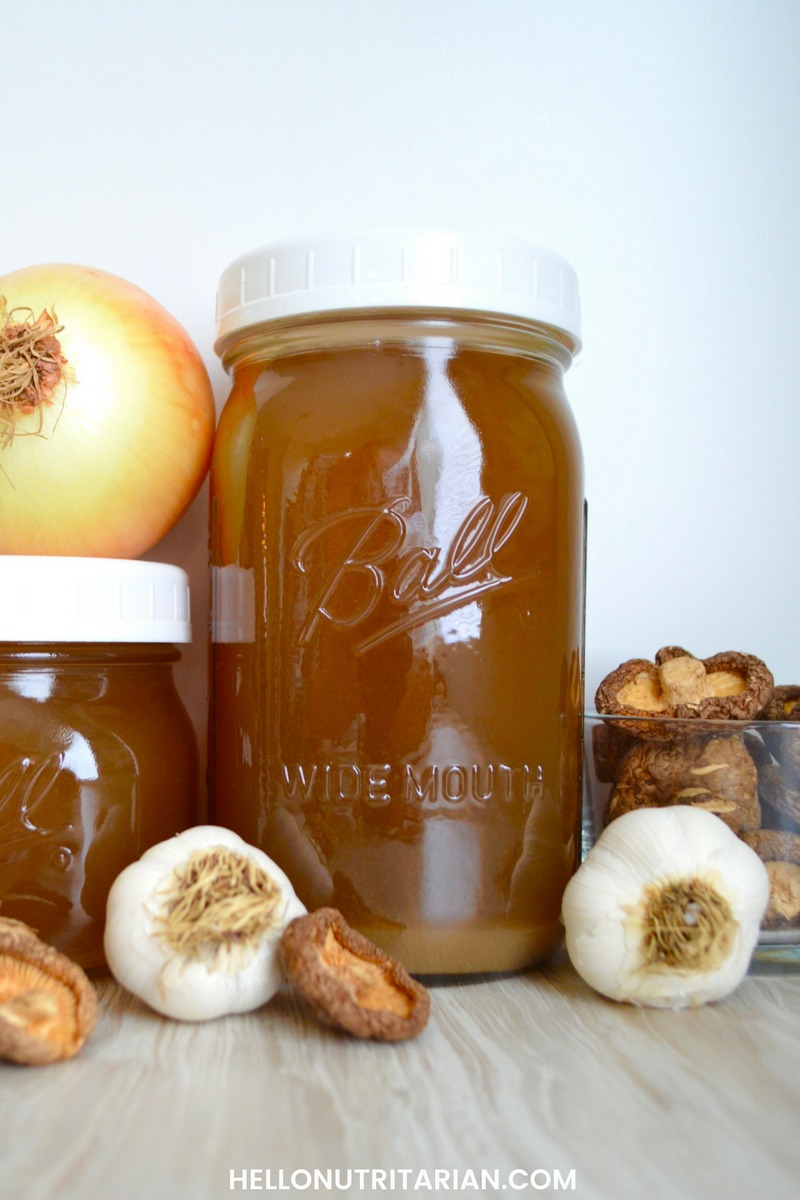 Your life-changing, low-sodium, Shiitake Ginger Broth recipe is here!
Your life-changing, low-sodium, Shiitake Ginger Broth recipe is here!
The hardest thing about nutrifying Asian recipes is reigning in the salt content.
For years I’ve lamented the lack of ginormous pho noodle soup bowls in my nutritarian life–then last year I stopped moping and I got to work.
Yes, this Shiitake Ginger broth has taken me nine months to get juuust right. I’ve made about six batches now. It was all about reaping maximum taste for the smallest sodium price tag!
I wanted this broth to look like those luscious Vietnamese pho broths I used to enjoy before changing to a whole food plant based (no-oil, low-salt) lifestyle.
When I shared a few pics of my “test broths” on Instagram and Facebook you all went wild! I get it! Amazing, good-for-you soup-broth makes me ridiculously happy too!
Now, I’m so, so excited to finally share this with you all, let’s get to it…
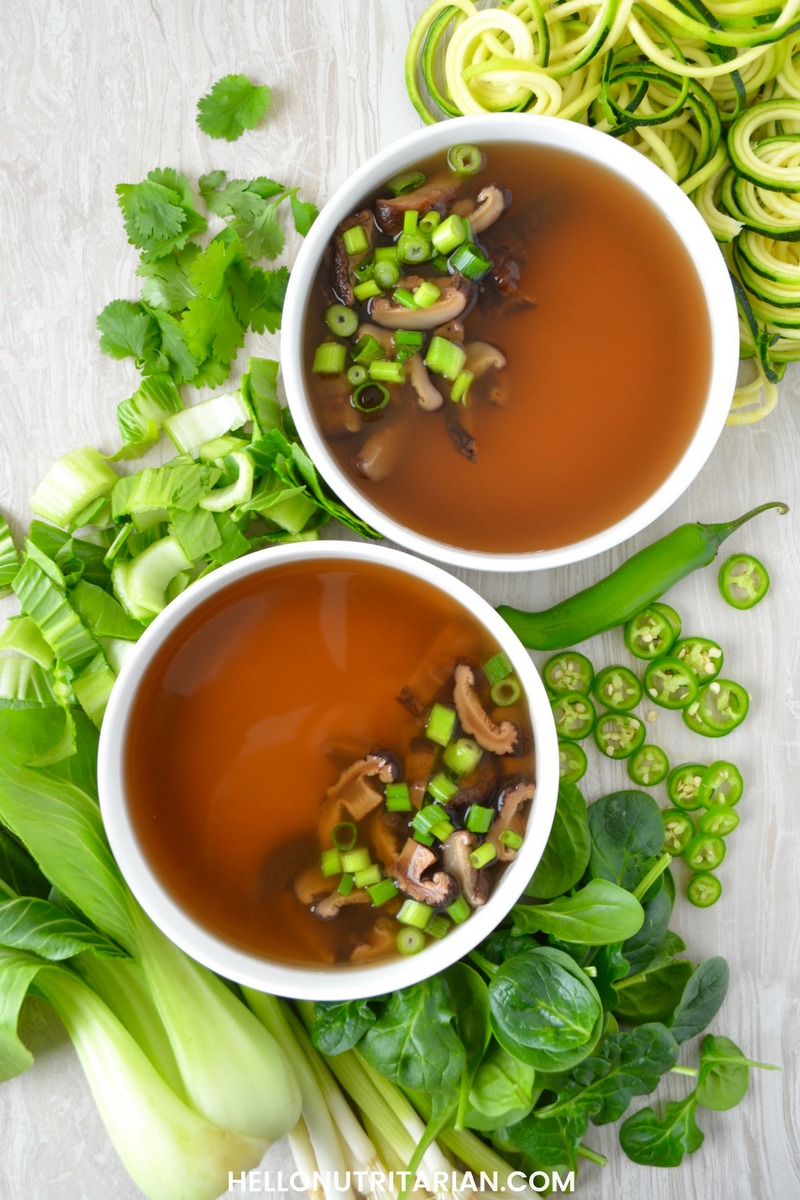 There’s Nothing This Broth Can’t Do
There’s Nothing This Broth Can’t Do
First of all, look at that amazing, deep, rich color.
It’s gorgeous.
And that’s exactly what this Shiitake Ginger Broth will do to your food–make it gorgeous.
Anything you throw into this broth only becomes better and tastier for having known it (and I’ve thrown a lot of things into this broth!). But it’s also magnificently simple and satisfying on it’s own.
It’s full of those nutritarian super-foods (like mushrooms, onions and garlic) that boost your immunity–I swear it shortened my last cold by at least 3 days.
I love that this broth uses cheap, simple, fresh produce:
- garlic
- onions
- ginger
- leeks
- celery
- green onions
- mushrooms
And you have lots of room to improvise using what you have on hand (we’ll be getting into that later).
But there is one specialty ingredient that takes the flavor of this broth over-the-edge…
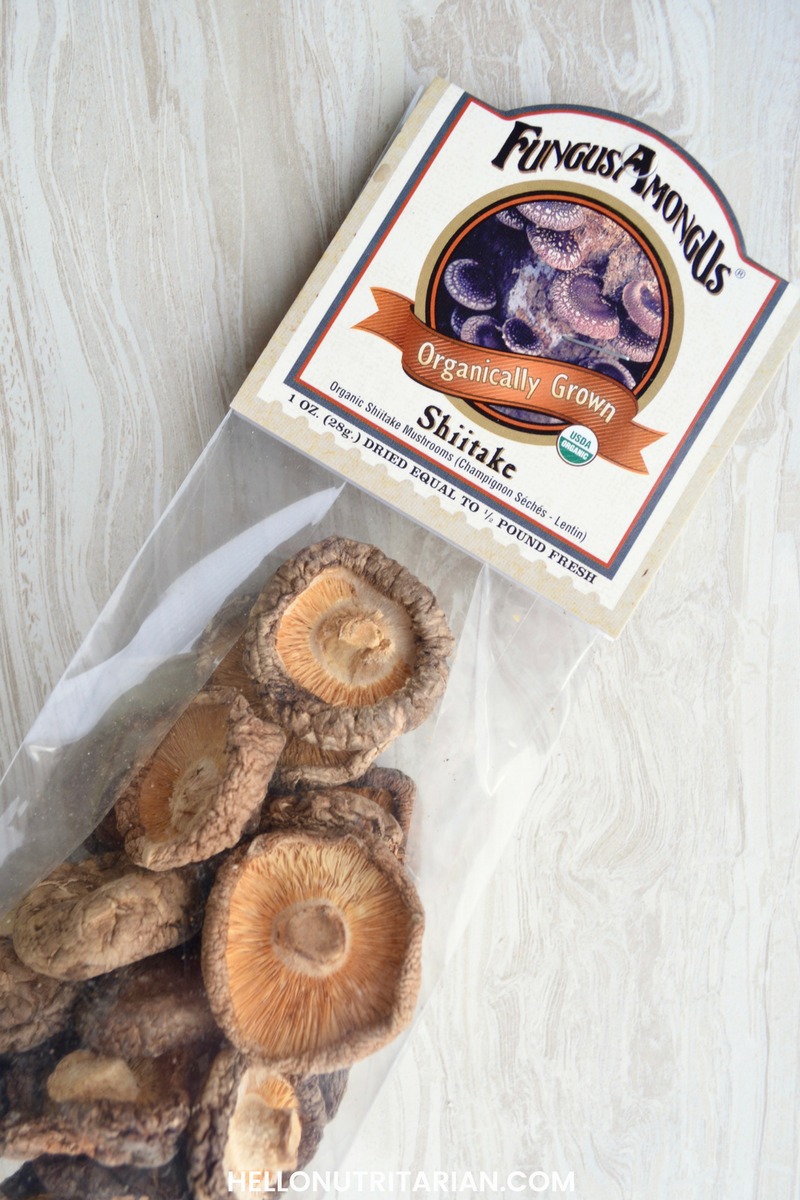 Dried Shiitake Mushrooms for the Win
Dried Shiitake Mushrooms for the Win
Here it is.
The secret weapon.
The smoking gun.
The way you get that amazing deep color and that incredible rich taste without all the “nasties” like oil, and tons of sodium.
If you’re feeling annoyed right about now at the thought of tracking down what seems like an obnoxiously-hard-to-find ingredient–just stop right there!
When you drive a fancy, exotic car you fill it up with premium gas. If you’re completely fine with watery, flavorless low-sodium pho broth then continue with your anti-specialty ingredient mentality.
But if you’re ready to taste the soup of your dreams then invest in some gosh-darn dried mushrooms please!
I get this Fungus Among Us brand at my local Whole Foods but you can get it cheaper on Amazon:
You only need 1 ounce of dried mushrooms to make a batch of broth which yields about 6 cups.
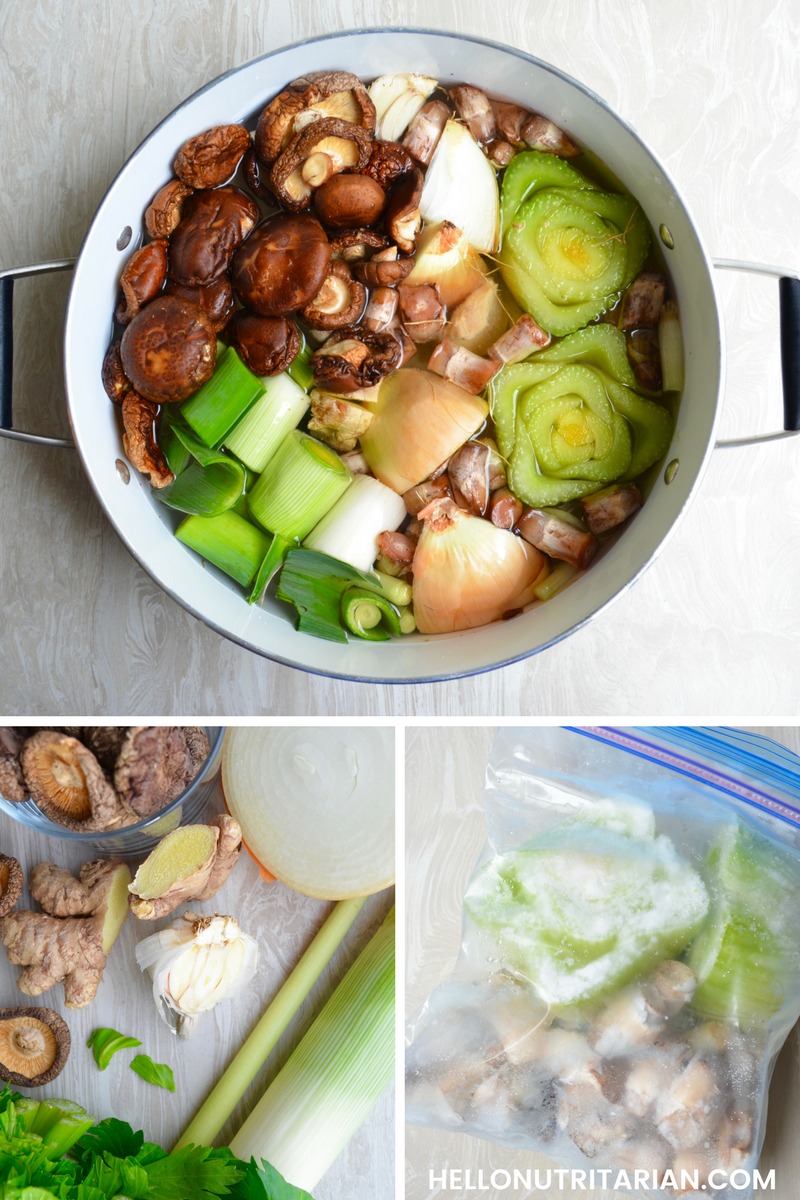 Save & Freeze Those Veggie Scraps
Save & Freeze Those Veggie Scraps
Evidently I’m very late to the make-your-own-veggie-broth party!
You all know that time is of the essence when I do my weekly batch prepping–being that I’m the sole nutritarian in my family of four. Because I’m always strapped for time in the kitchen, I’ve always found it easiest to grab a carton of low-sodium veggie broth for my recipes.
But when I had a mega-hankering for authentic-tasting pho broth, buying from the store wasn’t an option. Why? Because all the pre-made Asian-inspired broths are chock-full of sodium and oil.
So here’s what I did: I started a veggie-scrap bag in my freezer.
My favorite scraps to freeze for this broth are celery bottoms (can “celery butt” be a real thing, please?), green onion bottoms and mushroom stems. I prep these veggies weekly so it was easy to get a robust freezer collection going in no time!
You can do any combination of fresh and frozen veggie scraps that you want.
These are the veggies that work best with the flavor-profile of this broth:
- celery
- onion (yellow, white & green)
- mushrooms (any variety, in addition to the dried shiitake mentioned above)
- leeks
- shallots
Flavor-Enhancers:
- garlic
- ginger
- lemongrass
- dried shiitake mushrooms
Let’s Talk Salt Substitutes
The Shiitake Ginger Broth recipe uses both white miso paste and liquid amnos as salt substitutes.
Now, I’ve had a lot of comments from readers that say it’s hard to find white miso paste in certain parts of the country and if that’s the case for you, not a problem, you can use all liquid aminos instead. And I will have that substitution listed in the recipe below.
I’m very proud to report that there’s only 143 mg of sodium in each cup of this broth! With a standard serving size at 2 cups, you’re looking at 287 mg sodium per serving! Well within Dr. Fuhrman’s range of no more than 300 to 400 mg added sodium daily (when you’re following the Aggressive Weight Loss Plan).
The best part is, it doesn’t taste like it’s super-low sodium (yes, I’m patting myself on the back as I type this)!
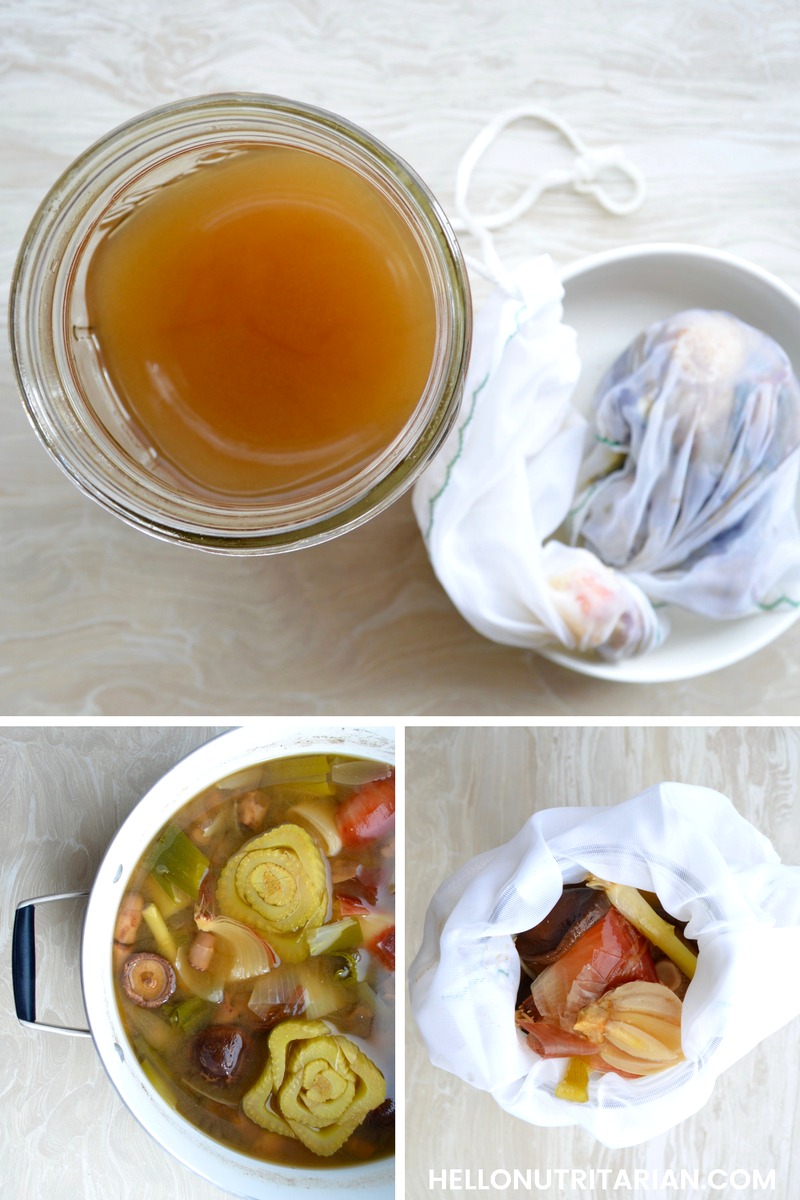 This Broth Needs Straining
This Broth Needs Straining
The best way to extract the most flavor from those boiled veggies is using a high-quality nut-milk bag.
I found this wide-mouth, 2-quart bag by Diana Stobo at my local Whole Foods and have had it for almost 2 years without trouble. Needless to say there’s been a lot of straining going on during that time and the seams are still strong and reinforced!
I like to do my broth straining in 3 batches.
First, I remove all the dried shiitake mushrooms (that are now plump and re-hydrated) and reserve them for slicing and adding to the finished pho noodle soup.
Then, I place my nut-milk bag inside my quart-sized, wide-mouth Mason jar and fill it up with a third of the broth and veggies and squeeze vigorously–because I want every. single. flavorful. drop.
I reserve the finished broth in Mason jars until I’m ready to make my Nutritarian Pho Noodle Soup recipe.
This broth will last for up to 12 days in the fridge and up to 2 months in the freezer!

Low-Sodium Shiitake Ginger Broth
Start a collection of veggie scraps in your freezer and use them to make this incredibly tasty oil-free, low-sodium, vegan, nutritarian Shiitake Ginger Broth that's perfect to use for big bowls of Vietnamese pho noodle soup!
Ingredients
- 8 cups water
- 2 celery stalk bottoms
- 1 - 2 leeks, large-diced
- 1 onion, quartered (skin on)
- 1 bunch green onion bottoms, whole
- 1 bulb garlic, halved (skin on)
- 1 knob ginger, large-diced (about 3 inches in width)
- 1 ounce dried Shiitake mushrooms
- 1 tbsp white miso paste (or sub 1 1/2 tsp. more liquid aminos)
- 1 tsp liquid aminos (reserved)
OPTIONAL:
- 1 stalk lemongrass, cut into 4 pieces (optional)
- 1/2 to 1 cup mushroom stalks (any variety)
Instructions
-
You can accumulate the needed veggie scraps over time by storing them in a baggie or jar in your freezer. This recipe works with fresh or frozen produce or any combination thereof.
-
In large stock pot with light-fitting lid add all the ingredients except the liquid aminos. Cover and bring to a boil over medium-high heat (about 20 minutes).
-
After the veggies reach a boil, stir the broth and lower heat to a simmer. Add the reserved liquid aminos. Allow to cook slowly for another 40 minutes or until all the veggies are very soft and can fall apart easily.
-
Remove the shiitake mushrooms and store for use later. Place your nut-milk bag inside a quart-sized Mason jar (or equivalent) and place 1/3 of the broth and cooked veggies into the bag. Twist the top of the bag down and keeping the bag in the jar, squeeze all of the liquid out of the bag. Repeat this process until the whole pot has been strained.
-
Compost veggie scraps.
Recipe Notes
Makes 6 cups of broth.
Keeps in the fridge for up to 12 days and in the freezer for up to 2 months.
Use for oil-free cooking or as a soup base.
I hope you give this Low-Sodium Shiitake Ginger Broth recipe as much as I do–I can’t wait to see the amazing dishes you’ll create with it!
If you give the recipe a try I’d love to know what you think, please leave a rating and comment below!


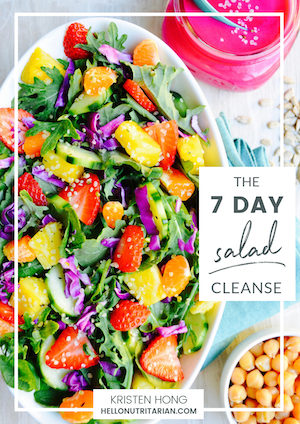





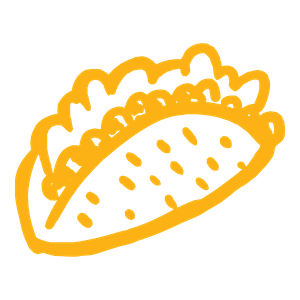


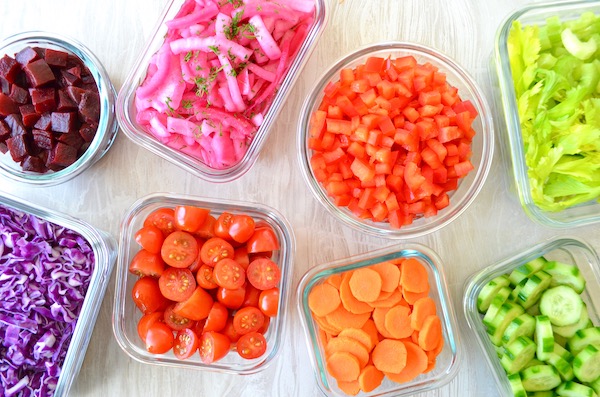
I would love to make this sauce it looks wonderful but I don’t eat onions or garlic which is in almost everything any ideas on substitutions. (This might be a tough one)
Hi Lynn,
Lol, yeah, that’s going to be a though one especially with this particular recipe.
I would say that all the garlic and onions are strained out of the broth, so if you’re okay with the flavors over actually eating them, that’s an option. Otherwise you could always just do the shiitake, ginger, lemongrass and extra celery!
Let me know if you give it a try!
xo, Kristen
This looks super yummy! We’re new to the Nutritarian way of eating and your blog makes all the food look super tasty and satisfying 🙂 We’re trying some of your meal prepping this week!
I would like to know though, why is it that your kids and husband do not follow the nutritarian diet? Is it just that they are less strict or do you make completely different meals for them? I’m married with 2 kids (2 & 4) and 1 of them has tummy issues so he’s the one I’m most trying to get straightened out via better eating.
Thanks for all the inspiration!
Lauryn
Hi Lauryn,
So happy to hear you’re finding the site helpful in your nutritarian journey! And VERY excited to hear you’re starting to batch prep–huge key to making this your forever lifestyle!!
My husband has been good about eating nutritarian dinners with me about 75% of the time unless he feels like something else and he’ll either make it himself or eat some of what the kids are having. He’ll add hot sauce or a bit of animal products to my nutritrian preps. The kids do not eat nutritarian but they do have to eat raw veggies before their meal and cooked veggies with their meal. Their dessert 90% of the time is fresh fruit.
As they get older I keep tightening up their diet a bit. Like, now we don’t keep cow’s milk at home. They can have it outside the home but not at home. Cheese is kept to a minimum and will probably be the next thing to be removed from our home!
xo, Kristen
This was a fun read and quite inspirational. I’ve been looking for something to substitute for soy sauce but every recipe I’ve seen so far has contained at least one ingredient from the allium family. Since your recipe was the most interesting and creative, I thought I would reach out to ask for your help. What would you recommend as a substitute for onion and garlic for those who don’t tolerate it?
Unlike this one, most of the other recipes contained beef broth (or powder) which seems like a shame to me. I think that a plant based sauce would be more versatile and practical in terms of food safety. Thank you for the tasty ideas!
Hi Pam, and thank you for your lovely comment!
For onion and garlic you could do shallots or leeks (if you tolerate those).
Also keep in mind this is a very low-sodium recipe so if you’re not used to the nutritarian lifestyle or not practicing it, you can always add salt in!
xo, Kristen
This looks great. I was wondering if you have any suggestions for making it in an Instant Pot.
Hi Sue,
No I don’t even have an Instant Pot but if you give it a try please let us know how it turns out!
xo, Kristen
Super easy! I only had half an oz of the shitake so i filled in witb portabello and it came out so yummy! I also threw it all in my crockpot for most of the day before draining.
So wonderful to hear it can work with those substitutions! And thank you for taking the time to leave a review and comment!
xo, Kristen
This is saving my life right now. I’m back on the nutritarian bandwagon in a more hardcore way because I really, really need to get my blood pressure down. Not having an good Asian broth was a despairing thought. I’m trying this tonight!
Any subs for leeks, green onion and lemon grass? Thank you cant wait to try!
Hi Brittny, I have a recipe in my cookbook where you collect veggie scraps in your freezer that is very similar to this and in that one I recommend green, yellow and white onions, celery, garlic, green cabbage, ginger and cilantro. So any of those could work as substitutes here as well!
This is an answer to Lynn’s question: Gourmend has garlic scape for those with sensitivity to garlic. It’s mild but very good.
I’m looking forward to trying this recipe! Just a note for those who are sensitive to onions, just use the green parts of scallions or leeks; and chives are good.
Thanks so much for taking the time to leave her a response–much appreciated, Adrienne!